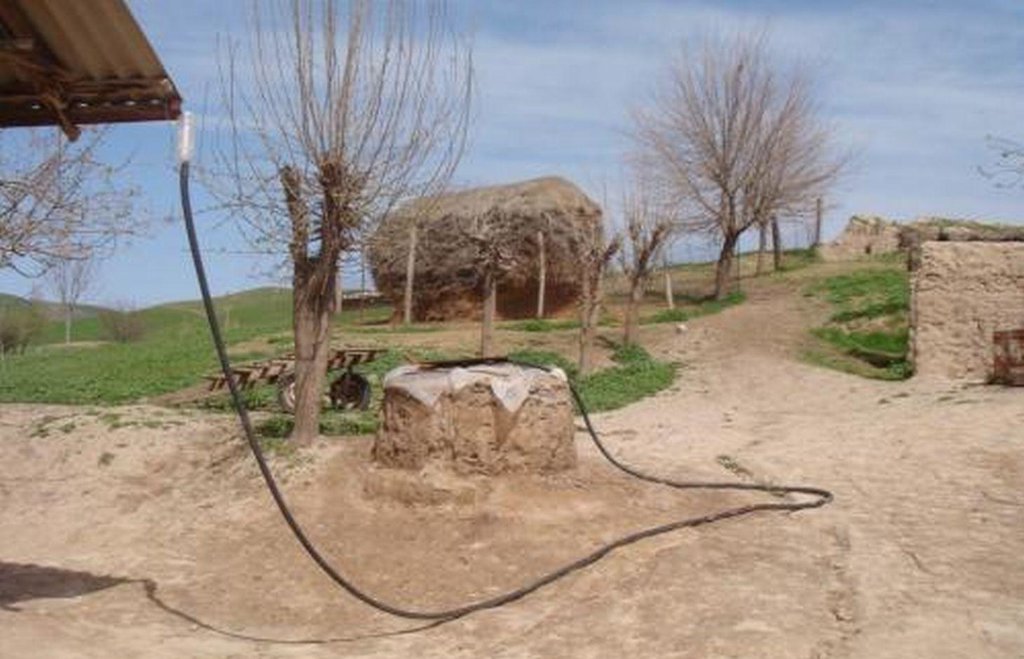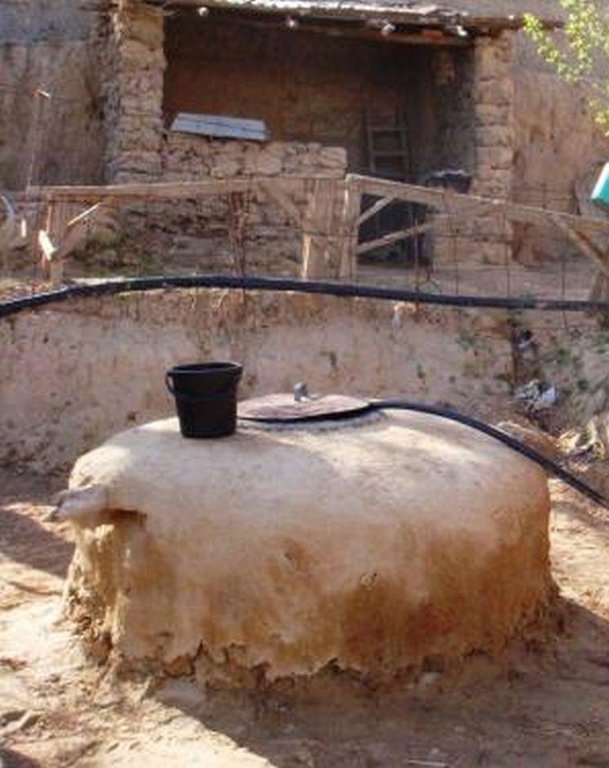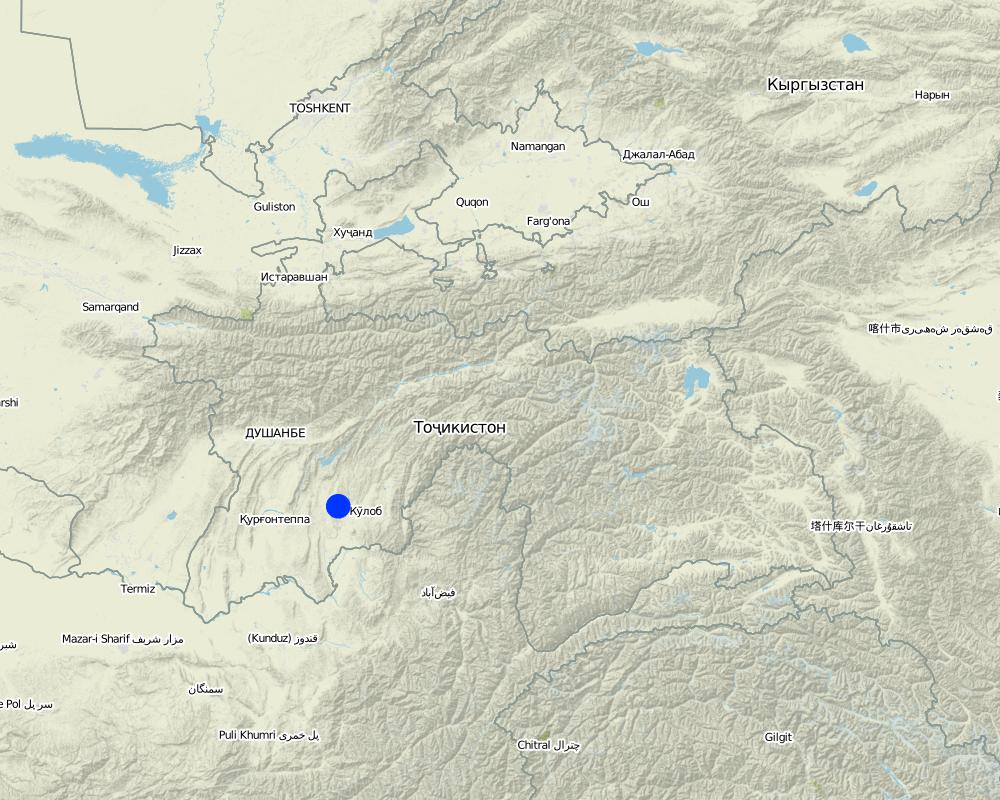Roof top rainwater harvesting stored in a polythene lined earth retention tank. [塔吉克斯坦]
- 创建:
- 更新:
- 编制者: Daler Domullojonov
- 编辑者: –
- 审查者: David Streiff
Чамъоварии оби борон аз руи боми хона
technologies_1446 - 塔吉克斯坦
- Roof top rainwater harvesting stored in a polythene lined earth retention tank.: Nov. 2, 2021 (public)
- Roof top rainwater harvesting stored in a polythene lined earth retention tank.: April 4, 2018 (inactive)
- Roof top rainwater harvesting stored in a polythene lined earth retention tank.: Aug. 15, 2019 (inactive)
- Roof top rainwater harvesting stored in a polythene lined earth retention tank.: July 19, 2017 (inactive)
- Roof top rainwater harvesting stored in a polythene lined earth retention tank.: May 6, 2017 (inactive)
- Roof top rainwater harvesting stored in a polythene lined earth retention tank.: March 14, 2017 (inactive)
查看章节
全部展开 全部收起1. 一般信息
1.2 参与该技术评估和文件编制的资源人员和机构的联系方式
SLM专业人员:
有助于对技术进行记录/评估的机构名称(如相关)
Deutsche Welthungerhilfe (Welthungerhilfe) - 塔吉克斯坦有助于对技术进行记录/评估的机构名称(如相关)
Pilot Program for Climate Resilience Tajikistan (PPCR Tajikistan) - 塔吉克斯坦1.3 关于使用通过WOCAT记录的数据的条件
(现场)数据是什么时候汇编的?:
06/04/2011
编制者和关键资源人员接受有关使用通过WOCAT记录数据的条件。:
是
2. SLM技术的说明
2.1 技术简介
技术定义:
The use of an earth tank lined with a polyethylene sheet to retain rainwater collected from the roof of the house.
2.2 技术的详细说明
说明:
An earth retention tank is a simple low cost structure that can be used to retain rain water from the rooftop. A hole is prepared and lined with a polyethylene sheet to prevent leakage. The top of the hole is covered with a metal lid for access. The roof of the house is fitted with a plastic guttering that captures the rainwater and funnels the water via a plastic pipe into the earth tank. The water in the earth tank then can be utilised for the irrigation of crops (especially during the hot dry summer months), sanitation, and potentially drinking water.
Purpose of the Technology: The population in Southern Tajikistan consists largely of subsistance farmers and are thus highly reliant upon their kitchen garden plots. As the population in the area continues to expand, the pressure on the land increases. The latter is already in a poor state, because it is becoming degraded through deforestation, overgrazing and general over exploitation. There is much precipitation during the rainy season from autumn until spring in Southern Tajikistan, but the scarcity of water from late spring to the end of autumn poses a problem with water shortages.
During the rainy season, a lot of water is lost as surface runoff, this water can be saved in a retention tank to be utilised during the dry season. It can be used to water crops to help increase yields as well as crop diversity and quality. The additional water can also be used for sanitation, drinking water and watering of livestock.
Establishment / maintenance activities and inputs: For the establishment of such a retention tank several steps are needed. In preparation, a rough estimation of the potential volume of harvested rainwater needs to be calculated. Thereafter, a location for the tank needs to be selected so that expenses are minimised and it is easy to access. The establishment of ponds near big trees is not recommended, because the polyethylene layer might be punctured by the roots.
Natural / human environment: The actual steps of constructing the tank involve:
(1) digging the pond, (2) plastering the inside walls with a fine soil and water mixture to smooth them, (3) lining the pond’s walls with double polyethylene layer, (4) connecting the inside polyethylene sheets with the pond coverage through a piece of cord, so that it can be taken out of the pond any time to be cleaned of sediments, (5) covering the pond with any available material such as a soil, water and straw mixture, reinforced by several poles, leaving an opening of 0.25 x 0.25m to extract water, (6) finally connecting the roof to the pond with a plastic pipe. To avoid dirty water flowing from the roof into the pond, the pipe should only be connected to the pond some time after the rainfall has started.
2.3 技术照片
2.5 已应用该技术的、本评估所涵盖的国家/地区/地点
国家:
塔吉克斯坦
区域/州/省:
Khatlon province
有关地点的进一步说明:
Temurmalik, Baljuvon
Map
×2.6 实施日期
如果不知道确切的年份,请说明大概的日期:
- 不到10年前(最近)
2.7 技术介绍
详细说明该技术是如何引入的:
- 通过项目/外部干预
注释(项目类型等):
The technology was developed through a Welthunger Hilfe Project and promotion in the local communities started in 2008.
3. SLM技术的分类
3.1 该技术的主要目的
- 改良生产
3.2 应用该技术的当前土地利用类型

定居点、基础设施
- 定居点、建筑物
注释:
Kitchen garden
注释:
Major land use problems (compiler’s opinion): Inefficient natural resource management, which is mainly visual because people throw potential organic fertilisers away instead of spreading them on the fields. Incorrect ploughing techniques which leads to the acceleration of erosion, deforestation and waste of fuel materials in inefficient stoves and ovens. Overgrazing leading to pasture degradation.
Major land use problems (land users’ perception): lack of water
Constraints of settlement / urban
3.3 有关土地利用的更多信息
每年的生长季节数:
- 1
具体说明:
Longest growing period in days: 180Longest growing period from month to month: March - November
3.4 该技术所属的SLM组
- 集水
3.5 技术传播
具体说明该技术的分布:
- 均匀地分布在一个区域
如果该技术均匀地分布在一个区域上,请注明覆盖的大致区域。:
- 10-100 平方千米
3.6 包含该技术的可持续土地管理措施

结构措施
- S5:大坝、集水斗、水池
注释:
Main measures: structural measures
3.7 该技术强调的主要土地退化类型

水质恶化
- Ha:干旱化
- Hs:地表水良变化
- Hp:地表水水质下降
注释:
Main type of degradation addressed: Ha: aridification, Hs: change in quantity of surface water, Hp: decline of surface water quality
Main causes of degradation: soil management (Inproper land management), deforestation / removal of natural vegetation (incl. forest fires) (Cutting trees and shrubs), overgrazing, inputs and infrastructure: (roads, markets, distribution of water points, other, …) (poor water supply)
Secondary causes of degradation: population pressure (the population is increasing over time.), poverty / wealth (lack of funds)
3.8 防止、减少或恢复土地退化
具体数量名该技术与土地退化有关的目标:
- 减少土地退化
- 修复/恢复严重退化的土地
注释:
Main goals: rehabilitation / reclamation of denuded land
Secondary goals: prevention of land degradation, mitigation / reduction of land degradation
4. 技术规范、实施活动、投入和成本
4.1 该技术的技术图纸
作者:
Daler Domullojonov, 14, Giprozem str., Dushanbe, Tajikistan
4.2 技术规范/技术图纸说明
Harvesting water from the household roof to an earth built retention pond with plastic sheet lining. The retention pond is covered with a removable metal plate for access.
Location: Davad village, Vatan jamoat, Temurmalik district,. Khatlon province, Tajikistan
Date: June 2009
Technical knowledge required for field staff / advisors: low (No special knowledge is needed for implementation)
Technical knowledge required for land users: moderate (Any farmer can implement, once they understand the basic concept.)
Main technical functions: control of concentrated runoff: retain / trap, control of concentrated runoff: drain / divert, water harvesting / increase water supply
Dam/ pan/ pond
Depth of ditches/pits/dams (m): 3.5
Width of ditches/pits/dams (m): 1.2
Length of ditches/pits/dams (m): 1.2
Construction material (earth): digging in earth, plastering and cover
Construction material (wood): pole for cover
Construction material (other): polyethelene sheets, plastic pipe
Specification of dams/ pans/ ponds: Capacity 3.96m3
Catchment area: 72 m2m2
Beneficial area: 0.2h.am2
For water harvesting: the ratio between the area where the harvested water is applied and the total area from which water is collected is: 1:0.5
4.3 有关投入和成本计算的一般信息
其它/国家货币(具体说明):
TJSomoni
注明美元与当地货币的汇率(如相关):1美元=:
4.5
注明雇用劳工的每日平均工资成本:
6.60
4.4 技术建立活动
| 活动 | 措施类型 | 时间 | |
|---|---|---|---|
| 1. | Manual digging of pond;smoothing and plastering;covering pond | 结构性的 | once in the beginning |
| 2. | polyethylene sheet and pipe procurement, preparation and placement; | 结构性的 | once in the beginning |
4.5 技术建立所需要的费用和投入
| 对投入进行具体说明 | 单位 | 数量 | 单位成本 | 每项投入的总成本 | 土地使用者承担的成本% | |
|---|---|---|---|---|---|---|
| 劳动力 | Manual digging of pond | Persons/day | 2.0 | 30.0 | 60.0 | 100.0 |
| 劳动力 | Placing sheet | Persons/day | 0.1 | 30.0 | 3.0 | 100.0 |
| 施工材料 | Wooden poles for pond | poles | 4.0 | 5.0 | 20.0 | 100.0 |
| 施工材料 | Earth | tons | 0.1 | 45.0 | 4.5 | 100.0 |
| 施工材料 | Polyethylene sheet | square meters | 10.0 | 2.3 | 23.0 | 50.0 |
| 施工材料 | Cord | meter | 20.0 | 0.025 | 0.5 | 50.0 |
| 施工材料 | Plastic pipe | meter | 5.0 | 2.0 | 10.0 | 100.0 |
| 施工材料 | Bucket | pieces | 1.0 | 4.5 | 4.5 | |
| 技术建立所需总成本 | 125.5 | |||||
注释:
Duration of establishment phase: 24 month(s)
4.6 维护/经常性活动
| 活动 | 措施类型 | 时间/频率 | |
|---|---|---|---|
| 1. | Cleaning of pond (washing out sediments) | 结构性的 | once every year |
| 2. | Changing polyethylene sheet;covering | 结构性的 | once every 2 years |
| 3. | Changing polyethylene sheet;covering | 管理 | once per 2 years |
4.7 维护/经常性活动所需要的费用和投入(每年)
| 对投入进行具体说明 | 单位 | 数量 | 单位成本 | 每项投入的总成本 | 土地使用者承担的成本% | |
|---|---|---|---|---|---|---|
| 劳动力 | Cleaning of pond (washing out sediments) | Persons/day | 0.1 | 45.0 | 4.5 | 100.0 |
| 劳动力 | Changing polyethylene sheet (every 2 years) | Persons/day | 1.0 | 10.0 | 10.0 | 100.0 |
| 施工材料 | Polyethylene sheet | square meters | 10.0 | 2.3 | 23.0 | 100.0 |
| 施工材料 | Cord | square meters | 1.13 | 8.85 | 10.0 | 100.0 |
| 施工材料 | Earth | tons | 0.05 | 45.0 | 2.25 | 100.0 |
| 技术维护所需总成本 | 49.75 | |||||
注释:
The above costs were calculated for the building of one retention tank. One household could have several ponds in one kitchen garden.
4.8 影响成本的最重要因素
描述影响成本的最决定性因素:
The type of earth in Tajikistan is very good for making the retention ponds, the labour is provided by the land user, and the plastic pipes can be manufactured out of empty plastic bottles. The polythene sheet and cord have to be purchased from the shop.
5. 自然和人文环境
5.1 气候
年降雨量
- < 250毫米
- 251-500毫米
- 501-750毫米
- 751-1,000毫米
- 1,001-1,500毫米
- 1,501-2,000毫米
- 2,001-3,000毫米
- 3,001-4,000毫米
- > 4,000毫米
有关降雨的规范/注释:
Average annual precipitation is 575 mm (according to data from the last 15 years), most of which falls between late autumn and spring time.
农业气候带
- 半干旱
Thermal climate class: temperate. 3 months below 5 degrees, 7 months above 10 degrees
Continental conditions
5.2 地形
平均坡度:
- 水平(0-2%)
- 缓降(3-5%)
- 平缓(6-10%)
- 滚坡(11-15%)
- 崎岖(16-30%)
- 陡峭(31-60%)
- 非常陡峭(>60%)
地形:
- 高原/平原
- 山脊
- 山坡
- 山地斜坡
- 麓坡
- 谷底
垂直分布带:
- 0-100 m a.s.l.
- 101-500 m a.s.l.
- 501-1,000 m a.s.l.
- 1,001-1,500 m a.s.l.
- 1,501-2,000 m a.s.l.
- 2,001-2,500 m a.s.l.
- 2,501-3,000 m a.s.l.
- 3,001-4,000 m a.s.l.
- > 4,000 m a.s.l.
关于地形的注释和进一步规范:
Altitudinal zone: Mainly communities in this range
5.3 土壤
平均土层深度:
- 非常浅(0-20厘米)
- 浅(21-50厘米)
- 中等深度(51-80厘米)
- 深(81-120厘米)
- 非常深(> 120厘米)
土壤质地(表土):
- 细粒/重质(粘土)
表土有机质:
- 低(<1%)
如有可能,附上完整的土壤描述或具体说明可用的信息,例如土壤类型、土壤酸碱度、阳离子交换能力、氮、盐度等。:
Soil fertility is medium and if it is not overused the fertility can be increased.
Topsoil organic matter: Usually locals collect cow dung and use it as fuel.
Soil drainage / infiltration is medium
Soil water storage capacity is medium because the loess material contains clay material
5.4 水资源可用性和质量
地下水位表:
5-50米
地表水的可用性:
匮乏/没有
水质(未处理):
不良饮用水(需要处理)
关于水质和水量的注释和进一步规范:
Ground water table can also be below 50 m.
Availability of surface water is so poor du to deforestation the natural water balance is disturbed.
5.5 生物多样性
物种多样性:
- 低
5.6 应用该技术的土地使用者的特征
非农收入:
- 收入的10-50%
相对财富水平:
- 贫瘠
个人或集体:
- 个人/家庭
性别:
- 女人
- 男人
说明土地使用者的其他有关特征:
Land users applying the Technology are mainly common / average land users
Population density: < 10 persons/km2
Annual population growth: 1% - 2%
100% of the land users are poor.
Off-farm income specification: In this example the farmer's son has migrated to Russia.
5.7 应用该技术的土地使用者拥有或租用的平均土地面积
- < 0.5 公顷
- 0.5-1 公顷
- 1-2 公顷
- 2-5公顷
- 5-15公顷
- 15-50公顷
- 50-100公顷
- 100-500公顷
- 500-1,000公顷
- 1,000-10,000公顷
- > 10,000公顷
这被认为是小规模、中规模还是大规模的(参照当地实际情况)?:
- 小规模的
5.8 土地所有权、土地使用权和水使用权
土地所有权:
- 州
- 个人,有命名
土地使用权:
- 个人
用水权:
- 个人
5.9 进入服务和基础设施的通道
健康:
- 贫瘠
- 适度的
- 好
教育:
- 贫瘠
- 适度的
- 好
技术援助:
- 贫瘠
- 适度的
- 好
就业(例如非农):
- 贫瘠
- 适度的
- 好
市场:
- 贫瘠
- 适度的
- 好
能源:
- 贫瘠
- 适度的
- 好
道路和交通:
- 贫瘠
- 适度的
- 好
饮用水和卫生设施:
- 贫瘠
- 适度的
- 好
金融服务:
- 贫瘠
- 适度的
- 好
6. 影响和结论性说明
6.1 该技术的现场影响
社会经济效应
生产
作物生产
饲料生产
畜牧生产
水资源可用性和质量
饮用水的可用性
SLM之前的数量:
120 litres
SLM之后的数量:
12000 litres
注释/具体说明:
Water storing capacity of household increased
灌溉用水的可用性
收入和成本
农业收入
SLM之前的数量:
0
SLM之后的数量:
100
注释/具体说明:
vegetables and greens are available for own consumption
工作量
注释/具体说明:
no need to carry water
社会文化影响
食品安全/自给自足
Livelihoods and human well-being
生态影响
水循环/径流
水量
注释/具体说明:
more water available
水的回收/收集
注释/具体说明:
more water available
地表径流
注释/具体说明:
only in kitchen garden
6.3 技术对渐变气候以及与气候相关的极端情况/灾害的暴露和敏感性(土地使用者认为的极端情况/灾害)
渐变气候
渐变气候
| 季节 | 气候变化/极端天气的类型 | 该技术是如何应对的? | |
|---|---|---|---|
| 年温度 | 增加 | 好 |
气候有关的极端情况(灾害)
气象灾害
| 该技术是如何应对的? | |
|---|---|
| 局地暴雨 | 好 |
| 局地风暴 | 好 |
气候灾害
| 该技术是如何应对的? | |
|---|---|
| 干旱 | 不好 |
水文灾害
| 该技术是如何应对的? | |
|---|---|
| 比较和缓的(河道)洪水 | 不好 |
其他气候相关的后果
其他气候相关的后果
| 该技术是如何应对的? | |
|---|---|
| 缩短生长期 | 好 |
注释:
To minimise the damage to the polyethylene waterproofing layers and, reduce evaporation rates, pond is covered. As the pond is dug into earth the temperature remains fairly stable. If precipitation decreases less water can be harvested.
6.4 成本效益分析
技术收益与技术建立成本相比如何(从土地使用者的角度看)?
短期回报:
非常积极
技术收益与技术维护成本/经常性成本相比如何(从土地使用者的角度看)?
短期回报:
非常积极
注释:
Before the implementation of this technology, one family would spend an avarage of $44.5 on one truck of water per month. A pond costs around $25 to build, and should provide families with around 4 months worth of water after the rainy season.
6.5 技术采用
- 大于 50%
如若可行,进行量化(住户数量和/或覆盖面积):
600 households (in an area of 10-100km^2)
在所有采用这项技术的人当中,有多少人是自发地采用该技术,即未获得任何物质奖励/付款?:
- 10-50%
注释:
58% of land user families have adopted the Technology with external material support
350 land user families have adopted the Technology with external material support
Comments on acceptance with external material support: In the initial stages of the project, they were provided with 50% of the costs of the polyethylene sheets and cord only.
42% of land user families have adopted the Technology without any external material support
250 land user families have adopted the Technology without any external material support
Comments on spontaneous adoption: After observing the benefits of the technology and the high cost benefit ratio, many people in the community and surrounding villages have replicated this technology themselves.
There is a strong trend towards spontaneous adoption of the Technology
6.7 该技术的优点/长处/机会
| 土地使用者眼中的长处/优势/机会 |
|---|
| Easy and quick to establish, and maintain. |
| 编制者或其他关键资源人员认为的长处/优势/机会 |
|---|
|
It is a low cost technology and can be made from many locally available materials. How can they be sustained / enhanced? To disseminate these ideas in areas with water scarcity through local Extension Service providers / NGOs or local inhabitants. |
|
It reduces the time and effort to collect water and also the cost to buy water. How can they be sustained / enhanced? Promotion of different water saving methods and technologies by interested and line departments. |
| More water available for gardening and household purposes |
|
Increases access to water for drinking and sanitation purposes. How can they be sustained / enhanced? Construction of larger and/or more tanks. |
|
Provides water for irrigation during the hot dry months, therefore improving crop diversity and yields. How can they be sustained / enhanced? Training and education on kitchen garden farming techniques to optimise the use of the extra water supply. |
6.8 技术的弱点/缺点/风险及其克服方法
| 土地使用者认为的弱点/缺点/风险 | 如何克服它们? |
|---|---|
| The polyethylene only lasts for 2-4 years. | To increase the number of layers or use a thicker polyethylene sheet |
| 编制者或其他关键资源人员认为的弱点/缺点/风险 | 如何克服它们? |
|---|---|
| The plastic layers have a limited lifespan. | To find thicker and more hardy materials, or apply multiple layers. |
| Th waterproof layer can easily be degraded by mice and large insects. | |
7. 参考和链接
7.2 参考可用出版物
标题、作者、年份、ISBN:
Brochure - Converting drought prone areas into productive gardens! Low cost options to improve rainwater harvesting in Southern Tajikistan rain fed areas …. and beyond! 2009
可以从哪里获得?成本如何?
Welthungerhilfe, Temurmalik office,
标题、作者、年份、ISBN:
Training film - Simple ways to improve management of kitchen gardens in Southern Tajikistan rain fed areas …. and beyond. 2009
可以从哪里获得?成本如何?
Welthungerhilfe, Temurmalik office
标题、作者、年份、ISBN:
Welthungerhilfe project final narrative report (144-912) - 2010
可以从哪里获得?成本如何?
Welthungerhilfe, Temurmalik office
链接和模块
全部展开 全部收起链接
无链接
模块
无模块





